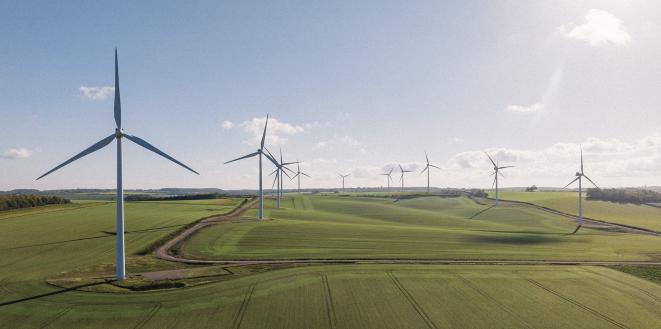Early competition
The energy landscape is undergoing a revolution. Changing generation and demand patterns are driving the need for substantial network investment to reach the UK government's Net Zero Target by 2050.
Electricity Transmission has a central role to play in the delivery of reliable and affordable greener power for consumers now and in the future. The introduction of competition to onshore electricity networks has a key role to play in improving efficiency in network investment, driving innovative solutions to network needs, and helping us meet our decarbonisation targets at the lowest cost to consumers.
Ofgem published their decision to proceed with the implementation of the early competition in March 2022. The Government’s Transmission Acceleration Action Plan positioned competition to start in 2024. We are now progressing work to launch early competition in line with this.
As we have progressed with implementation, we have incorporated other developments including our transition into NESO and changes to network planning. Other changes include the connections reform and procurement act 2023.

What is early competition?
Early competition is a competitive process to select a bidder a solution or a specific need on GB's electricity transmission system. The process begins "early", prior to the detailed design, surveying and consenting phases of solution development. This means organisations could compete for the design, build and ownership of onshore transmission solutions. Early competition will help encourage new ways of working and aims to seek the best solutions at a fair cost for consumers.
What are we trying to achieve?
Competition in network development has the potential to unlock millions of pounds of consumer value by encouraging those who are responsible for transmission assets to use more innovative and cost-effective solutions to meet the needs of the electricity system. The Government has indicated that, through the introduction of competition, consumers could see savings of up to £1 billion by 2050 on projects tendered over the next ten years.
Competitive pressure and involvement of new parties is likely to drive innovation and generate a wider range of ideas for solutions to system needs.
There could be innovation in areas such as technology, design, supply chain management, raising of finance and operations.
Effective competitions should be open to as many potential solutions as possible, including proposals from a full range of network (solutions requiring a transmission licence).
As NESO leads Great Britain’s transition to net zero, cost savings achieved through the introduction of early competition will be important in helping drive lower transmission charges and make investment in low carbon generation more affordable or cheaper.
This benefit is particularly important considering the role of NESO in supporting Great Britain achieving net zero.
We hope that early competition could also encourage sustainability as we are exploring whether this could be part of the criteria for tenders.

What happens next?
We are now in the process of developing the detailed tender process and commercial model, establishing project identification processes, and working with Ofgem to establish the frameworks required to underpin early competition.
We are also progressing the modifications to the required industry codes to enable the implementation of network competition. Throughout this timeframe we will work with industry to prepare for the first tender and share developments with stakeholders through appropriate forums. This also includes potential code changes.
Throughout 2024, Ofgem will provide more clarity on roles and responsibilities, and consult on these.
A glimpse to the past
Ofgem reviewed our Early Competition Plan submitted in April 2021 and announced their decision in March 2022 to progress early competition. Since then, NESO has led the implementation of this process.
As part of implementation, we’ve considered recent changes and updated the model and processes as appropriate and worked with stakeholders throughout this.
The journey to developing our plan
In February 2020 we published our Phase 1 update.
Our Phase 2 consultation was open for 6 weeks, between 3 July 2020 and 14 August 2020, where we consulted on the end-to-end model.
Stakeholder engagement was key in order to develop our Phase 2 proposals, with feedback received at our May workshops and bilaterals informing our proposals.
We received 7 responses from a range of stakeholders including Transmission Owners and potential new market entrants.
Our Phase 3 consultation was open for 10 weeks, between 3 December 2020 and 15 February 2021. Where we consulted on further details of the end-to-end model, following on from our Phase 2 consultation.
Stakeholder engagement was key in order to develop our Phase 3 proposals, with feedback received at our September workshops and bilaterals informing our proposals.
We submitted our Early Competition Plan to Ofgem on 30 April 2021.
To form our proposals, we took into consideration all stakeholder feedback received throughout the development of the plan including Phase 3 consultation responses.
Ofgem published their decision on this on 28 March 2022.
Following submission to Ofgem we have commenced low-regret implementation in the aim of reducing implementation timescales following decision. Potential activities which we aim to commence are:
- Finalise process for identifying possible projects
- Explore potential for expanding Pathfinders as a pre-legislative form of early competition
- Identifying code changes for post decision
- NESO organisational design development
We have published a range of documents throughout the early competition project.
We are committed to transparency and providing useful information to the industry, and all our documents are available to download.
Early Competition implementation (ECI) update
Early Competition Plan
Our Request for Information (RFI) document has been uploaded below, we are also inviting users to complete this survey to respond to this RFI.
Past phase documents
Once we received direction from Ofgem to proceed with the implementation of early competition, we established a programme of work to further develop the tender process, the commercial model, and technical requirements for early competition. To enable early competition, there is additional work in terms of code changes, policy and ongoing stakeholder engagement. The February 2024 update report details this work.
Since the decision to implement early competition, there has been work to support the development of the relevant legislation as well as consideration and adaptation of the model in response to other policy changes. In summary these are:
April 2022: announcement that the ESO would move to become an independent energy system operator. The work to achieve this has been ongoing and the National Energy System Operator (NESO) will commence in the summer of 2024.
May 2022: New procurement legislation was introduced to Parliament in the Procurement Bill. This legislation gained Royal Assent as the Procurement Act 2023 in November 2023 and once it comes into force, will replace the Utilities Contract Regulations 2016 (“UCR”) and Public Contracts Regulations 2015 (“PCR”).
July 2022: the Energy Security Bill (later referred to as the Energy Bill) was introduced. This achieved Royal Assent as the Energy Act 2023 in November 2023. The Act contains the legislation for competitively appointed transmission owners (CATOs) and is supported by secondary regulations.
We identified the changes needed to the relevant industry codes to introduce CATOs and set out how they will connect to the national electricity transmission system (NETS). Proposals were developed and have progressed through the code change processes. Details of these can be found on the codes pages.
Notable changes that have been considered as part of the implementation phase are the development and Ofgem decision on the Centralised Strategic Network Plan (CSNP). This involves the development of a new approach to planning the energy system. The new approach has led to changes in the model being proposed. The criteria for competition have also been refined to consider connections projects.
We have carried out work to develop the detail of the commercial model for early competition. These proposals have been published and shared with Ofgem ahead of their consultations. This includes the legal structure for bidders, preliminary works payments, the post preliminary works cost assessment (PPWCA), the revenue period and asset transfer. The payment mechanisms and proposals for additional works have also been developed.

Early competition plan: a plan for onshore electricity transmission
Read our plan to find out more on our proposals for early competition.
More useful links
Ofgem - Decision on the framework for the Future System Operator’s Centralised Strategic Network Plan (Ofgem, December 2023)
Electricity networks: transmission acceleration action plan (Government response to Electricity Network Commissioner’s report, November 2023)
Accelerating electricity transmission network deployment: Electricity Networks Commissioner’s recommendations (Winser Review, August 2023)
Centralised Strategic Network Plan: Consultation on framework for identifying and assessing transmission investment options (Ofgem, July 2023)
Decision on early competition in onshore electricity transmission networks (Ofgem, March 2022)
Early Competition Plan (ESO, April 2021)
NESO Network Planning Review (NPR) webpage
Network Services Procurement – Pathfinders and Stability Market
Information about the industry codes and specific code modifications
The criteria for running an Early Competition are being developed with stakeholders as part of the work to develop the Early Competition Plan.
In the RIIO-2 Sector Specific Methodology Decision Document published May 2019, Ofgem asked TOs to set out in their RIIO-2 business plans projects which met an ‘early competition’ criteria – projects that are at least £50 million in value and which are contestable (i.e. there is potential for alternative solutions). In the recent tCSNP and NOA reports, projects that meeting the criteria for early competition have been identified. This was to provide initial visibility of the pipeline of potential projects. Ofgem expect the final criteria to be developed as part of the implementation of Early Competition.
We sought are seeking further input to this question through our Phase 2 Consultation.
No, Ofgem see a role for both early and late competition.
The Early Competition Plan project focuses solely on models of Early Competition, where the competition occurs before a detailed solution is produced.
Ofgem are continuing to develop the process for late competition (i.e. competition that occurs after the solution is designed and consented).
NESO has already begun the process of introducing competition into electricity transmission through our Network Development Roadmap Pathfinders.
The pathfinders focus on seeking wider “whole system” solutions to transmission system needs that do not require a transmission license.
However, the pathfinders are limited to the procurement of non-network services, while early competition looks to facilitate competition across both network and non-network transmission solutions.
As the development of both processes continues, we will consider the circumstances where each approach is most appropriate and where, in future, they can potentially be merged.

Events and webinars
The success of our Early Competition Plan relied on our ability to bring together a range of expertise from across the energy industry and beyond. Throughout the development of our plan, we hosted workshops and webinars during each phase of the project.
If you'd like to find out more on Early Competition and how we worked with industry to form our proposal, watch the webinars on this page.
Get involved with the early competition
Sign up to our newsletter
Sign up to our newsletter get the latest on the early competition plan.
Email us
If you've not found what you're looking for, get in touch with the project team.


